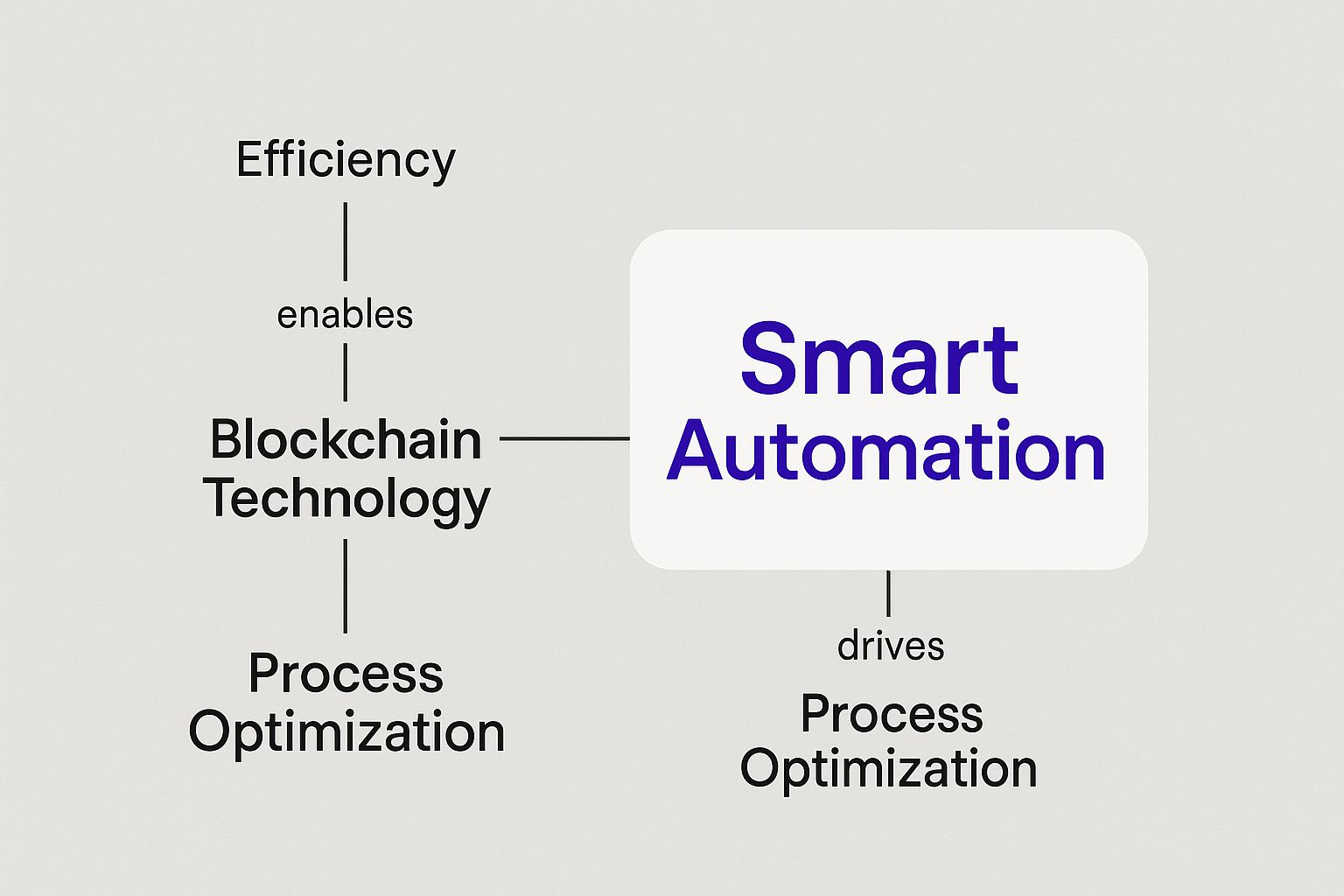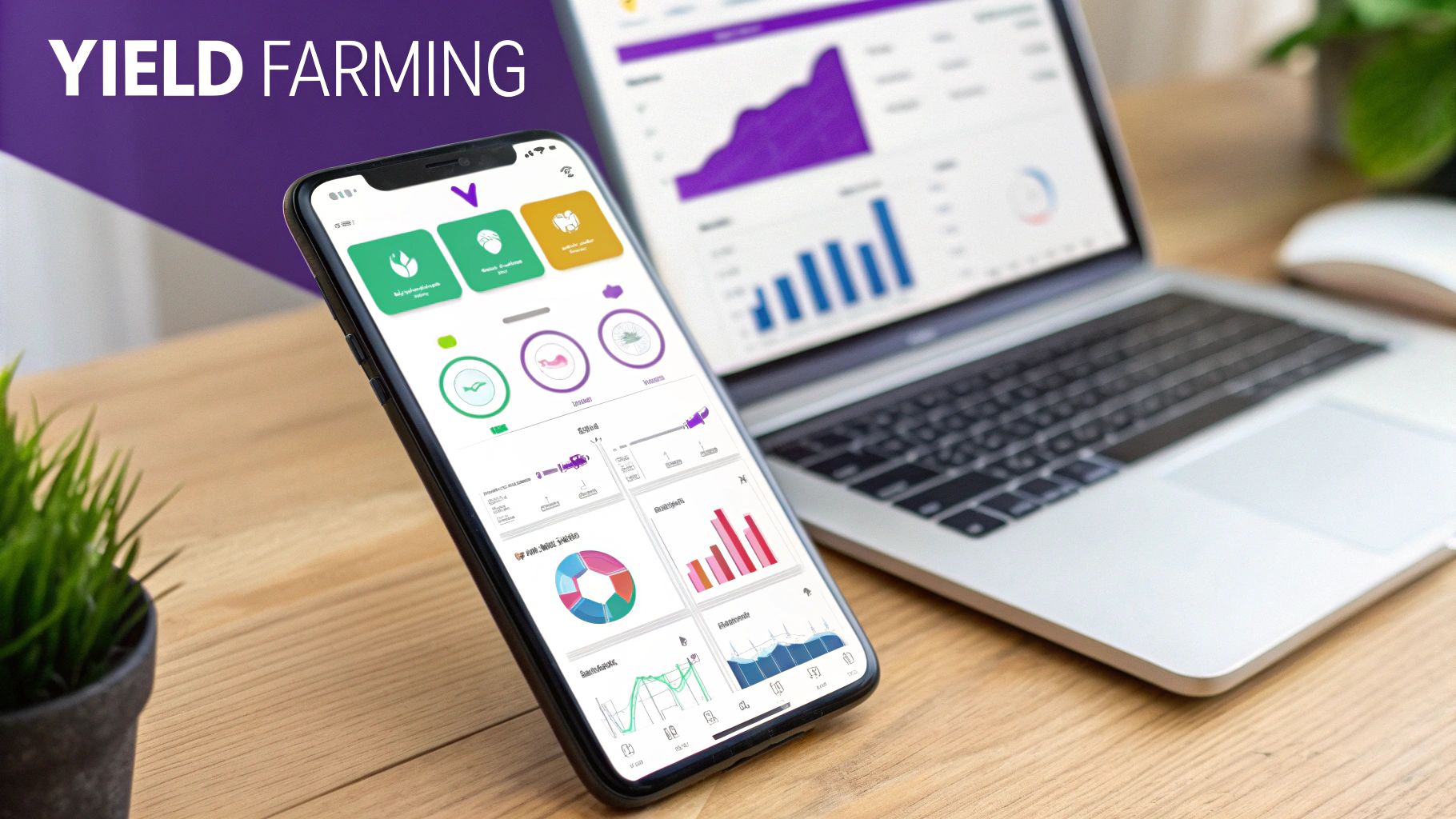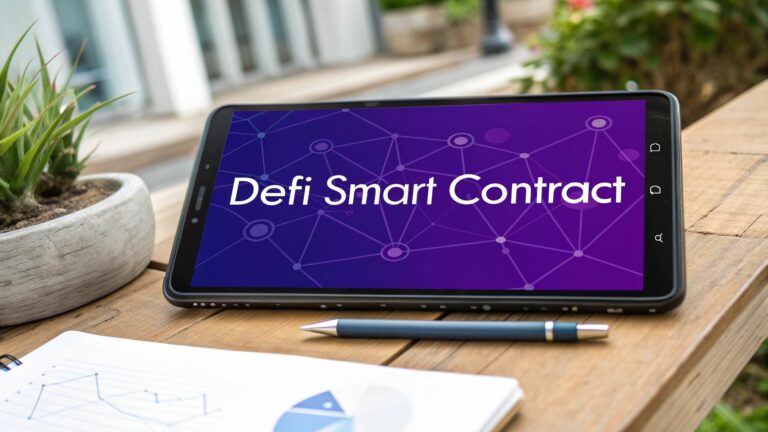Ever wonder how Decentralized Finance (DeFi) actually works its magic without bankers, brokers, or middlemen? The secret sauce is something called a DeFi smart contract.
Think of it like a high-tech, digital vending machine. But instead of grabbing a bag of chips, you’re accessing complex financial services like loans, trades, or investment earnings. These aren't your typical paper contracts; they are self-executing agreements written in code that live on a blockchain.
How the Digital Vending Machine Works
At its very core, a DeFi smart contract is the engine that drives the whole decentralized ecosystem. It’s what allows us to cut out traditional intermediaries—the banks, clearinghouses, and agents—and replace them with transparent, unstoppable code.
This code typically runs on a public blockchain, like Ethereum, which functions as a massive, shared global computer. Anyone can see it, anyone can use it, but no single person or company owns it. This isn't just a niche corner of the internet, either. The global smart contracts market was valued at USD 2.02 billion and is forecast to explode to roughly USD 815.86 billion by 2034, according to a recent smart contracts market report.
This astronomical growth signals a major shift in how we think about agreements—moving from paper and promises to automated, self-enforcing code.
The "If-Then" Logic That Powers Finance
The beauty of a DeFi smart contract lies in its simple, unbending logic: "if this happens, then do that." These rules are programmed directly into the contract and, once launched on the blockchain, they can't be changed or tampered with.
A smart contract is basically a traditional legal contract translated into computer code. Instead of relying on a court to enforce it, the blockchain network itself guarantees the terms are met automatically.
This automation is what makes DeFi so incredibly efficient. For example, a decentralized lending platform could have a smart contract with a rule like: "IF a borrower sends 1.5 ETH as collateral, THEN instantly send 1,000 USDC to their wallet." The whole thing happens in seconds, with no credit checks, no paperwork, and no waiting for a loan officer's approval.
This fundamental idea—automated execution on a secure public ledger—is a cornerstone of many modern blockchain projects. You can see this principle in action in our deep dive into what Algorand is and how it works. It’s this departure from human gatekeepers to automated code that is paving the way for a more open and efficient financial world.
To really grasp the difference, let's compare the old way with the new.
Traditional Finance vs DeFi Smart Contracts
This table breaks down the key distinctions between a classic financial agreement and one powered by a DeFi smart contract. It’s a snapshot of just how much the game has changed.
| Feature | Traditional Finance | DeFi Smart Contract |
|---|---|---|
| Intermediary | Required (banks, lawyers, brokers) | None (code is the intermediary) |
| Enforcement | Legal system, courts | Automatic execution by the network |
| Transparency | Opaque, private ledgers | Fully transparent on a public blockchain |
| Speed | Days or weeks | Seconds or minutes |
| Accessibility | Restricted by geography, credit | Open to anyone with an internet connection |
| Cost | High fees for middlemen | Low, predictable network fees |
| Trust | Trust in institutions and people | Trust in immutable code and math |
As you can see, the shift is profound. DeFi isn't just about digitizing existing finance; it's about rebuilding its very foundations on principles of automation, transparency, and accessibility.
How a DeFi Smart Contract Actually Works
To really get your head around how a DeFi smart contract works, let's forget about the code for a minute. Think of it like baking a cake, but in a super secure, fully automated kitchen. The blockchain itself—say, Ethereum—is that shared kitchen. It's unchangeable, so once something happens there, the record is permanent. The smart contract? That's your digital recipe.
But this isn't just a list of ingredients and steps. This "recipe" is a living, breathing program that executes on its own. It's written in a language like Solidity or Vyper and contains all the digital ingredients and instructions needed to build a completely autonomous financial tool.
This graphic gives you a great visual of how these automated parts snap together.

As you can see, the core idea is that the code running on the blockchain powers smart automation. That automation is precisely what makes DeFi so efficient and reliable.
The Core Components of the Recipe
No matter what a DeFi smart contract is designed to do, it's always built from a few key parts. These building blocks determine what the contract knows, what it can do, and how it talks to the outside world.
-
State Variables: These are your ingredients. They store all the vital information the contract needs to track, like user account balances, the terms of a loan, or who owns what. For instance, a lending protocol would have a state variable for "total USDC supplied."
-
Functions: Think of these as the cooking instructions. Functions are the specific actions the contract is allowed to perform. When you send a transaction to the contract, you're triggering one of these functions, like
deposit(),withdraw(), orswapTokens(). -
Events: These are like the oven timer dinging. Events are notifications the contract sends out to announce that something has happened. An app's front end can "listen" for these events, such as
LoanRepaidorTokensSwapped, to update what you see on your screen.
These aren't just abstract concepts; they are the active components in every single decentralized app you use.
A Step-by-Step Transaction
Let’s walk through a real-world example. Imagine you want to use a decentralized exchange (DEX) to swap some of your Ethereum (ETH) for a stablecoin. You can get the full scoop on popular options like USD Coin (USDC) and its underlying technology in our detailed guide.
Here's a play-by-play of how the DEX's smart contract handles your trade:
-
Initiation: You connect your crypto wallet to the DEX's website and enter that you want to swap 1 ETH. Simple enough.
-
Function Call: Your wallet then packages and sends a transaction to the DEX's smart contract, specifically calling the
swapExactETHForTokensfunction. Your 1 ETH is included in this transaction. -
State Verification: The contract’s code immediately checks its internal records (the state variables). Does it have enough USDC liquidity to handle your trade? It calculates the current exchange rate on the fly based on the asset balances in its liquidity pool.
-
Execution and State Change: If everything checks out, the contract executes the swap. It sends the correct amount of USDC to your wallet and adds your 1 ETH to its own reserves. This action instantly updates its internal state variables, changing the ETH and USDC balances for the next person.
-
Event Emission: Finally, the contract broadcasts a
Swapevent. This acts as a public receipt, confirming the details of your trade on the blockchain for anyone to verify.
At its heart, a DeFi smart contract is an impartial executor of predefined rules. It doesn't care who you are, only that your request meets the coded conditions. This mathematical certainty replaces the need for institutional trust.
Putting DeFi Smart Contracts to Work

This is where the rubber meets the road. The true magic of a DeFi smart contract happens when its automated logic gets applied to solve real-world financial problems. These aren't just abstract ideas; they're the engines driving multi-billion dollar protocols that are actively changing how we trade, lend, and invest our digital assets every single day.
What we're seeing is a fundamental shift in trust. Instead of placing our faith in institutions, we're now trusting transparent, verifiable code. You no longer need a centralized company to manage an order book or approve a loan. Instead, users can interact directly with an autonomous contract that plays by its own rules, without bias or delay.
Decentralized Exchanges (DEXs)
One of the most powerful examples of a DeFi smart contract in action is the decentralized exchange (DEX). Platforms like Uniswap have completely upended how people swap cryptocurrencies by throwing out the old-school order book model used by centralized exchanges.
They use something called an Automated Market Maker (AMM) model instead. A DEX’s smart contract manages pools of paired assets (think ETH and DAI). When you want to trade, you aren't bartering with another person—you're dealing directly with the smart contract. It algorithmically sets the price based on the ratio of assets in the pool, solving a huge problem by letting anyone swap tokens whenever they want.
Lending and Borrowing Platforms
Another game-changer is the decentralized lending protocol. Think of these platforms as automated banks, but without the bankers, endless paperwork, or long waits for approval. A user can drop their assets into a lending pool to earn interest, or they can put up collateral to borrow other assets.
A DeFi smart contract in a lending protocol is like an autonomous loan officer, treasurer, and risk manager all rolled into one. It enforces collateral rules, calculates interest rates on the fly based on supply and demand, and automatically liquidates shaky positions to keep lenders safe.
Platforms like Aave are a fantastic example of this system working flawlessly. An intricate web of smart contracts handles the entire process of deposits, loans, and interest payments. This automation has made borrowing more accessible and lending more profitable for people all over the world. If you're curious about the mechanics, you can find a deeper analysis of Aave and its token in our guides.
Yield Farming and Automated Strategies
Beyond simple swaps and loans, DeFi smart contracts are opening the door to more sophisticated financial maneuvers, especially yield farming. This is where users hop their funds between different lending and liquidity protocols to chase the highest possible returns.
Yield farming protocols use complex smart contracts to automate these strategies, which would otherwise be incredibly time-consuming. These "vault" contracts can do things like:
- Harvest rewards from one protocol automatically.
- Sell those reward tokens for other assets.
- Reinvest the new assets back into the pool to compound the gains.
This automation transforms what was once a high-effort, expert-level strategy into something much more passive. The explosive growth in this niche speaks for itself. In fact, the overall DeFi market is projected to hit an eye-watering USD 351.75 billion by 2031, with lending and payment protocols leading the charge. You can dig into these DeFi market trends and projections to get a better sense of just how massive this space is becoming.
The Real Benefits of Using DeFi Contracts
So, why all the buzz? What makes this technology so important? The real power of a DeFi smart contract comes from the massive advantages it has over the old way of doing finance. We're not talking about small improvements here. This is a complete teardown and rebuild of how financial services work, shifting from secretive, walled-off institutions to open, automated networks that anyone can join.
The growth numbers tell the story. The global DeFi market, which was valued at USD 32.36 billion, is on a trajectory to hit an eye-watering USD 1,558.15 billion by 2034. This incredible explosion is fueled by a worldwide demand for finance that's both transparent and free from gatekeepers. You can dig into more data on the DeFi market's exponential growth at Precedence Research.

Unlocking Unprecedented Transparency
Let's be honest: traditional finance often feels like a black box. The books are private, big decisions happen behind closed doors, and you’re basically forced to trust that institutions are playing fair. DeFi smart contracts completely flip that script.
Since these contracts live on public blockchains, every single transaction, rule, and account balance is out in the open for anyone to inspect. This radical transparency doesn't rely on a company's reputation to build trust; it uses cold, hard math. You don't have to hope a protocol is financially sound—you can check its reserves on the blockchain yourself.
Breaking Down Financial Barriers
This might be the biggest game-changer of all: true accessibility. For centuries, getting access to powerful financial tools depended on your location, your wealth, and your connections. DeFi smart contracts tear those walls down.
All it takes is an internet connection and a crypto wallet to plug into a global financial system. No gatekeepers. No credit checks. No one demanding to see your passport. This unlocks a world of lending, borrowing, and investing for billions of people who have been shut out of the legacy system.
Composability is DeFi's superpower. Every DeFi smart contract is like an open API that anyone can plug into. This creates an environment where innovation happens at a blistering pace, as developers are free to build on top of existing work.
The Power of Money Legos
This open-for-all approach creates something uniquely powerful called composability, which people in the space often call "money legos." Think of each DeFi smart contract as a single Lego block designed for a specific task—one handles swaps, another manages lending, and a third creates a stablecoin.
Because they're all open, developers can snap these existing blocks together in new ways to build brand-new financial products without having to start from zero. For instance, a savvy developer could whip up a new smart contract that automatically:
- Borrows crypto from a lending protocol like Aave.
- Swaps those borrowed funds on a decentralized exchange like Uniswap.
- Deposits the newly acquired asset into a yield farm to start earning rewards.
This plug-and-play structure sparks innovation at a speed that’s simply impossible in the siloed, disconnected world of traditional finance. It also lets users get creative with maximizing their returns through strategies like staking. You can learn more about how to earn rewards with crypto staking in our detailed guide.
Understanding the Risks and Security Threats
While DeFi smart contracts offer immense power, that power comes with some serious responsibility—and undeniable risk. It turns out the very things that make them so potent, like being unchangeable and running on their own, can also become their biggest weaknesses if you're not careful. Getting a handle on these threats is the first step to navigating the DeFi space without getting burned.
The most glaring danger comes down to smart contract bugs. A DeFi contract is just code, after all. A single typo, a flaw in logic, or an unexpected vulnerability can lead to absolute disaster. Once that flawed code is live on the blockchain, it's usually there for good, creating a permanent welcome mat for hackers.
These aren't just hypothetical what-ifs. The history of DeFi is littered with high-profile hacks where tiny coding mistakes led to the loss of millions, and in some cases, hundreds of millions of dollars. This reality hammers home just how critical rigorous testing and professional code reviews are before a contract ever touches a single dollar of user funds.
The Problem of Bad Information
Another huge vulnerability is what we call oracle risk. Smart contracts often need to pull in information from the outside world—like the current price of Ethereum—to do their job. This data comes from services called "oracles," which act as the bridge between the blockchain and real-world data.
The risk here is pretty simple: what happens if the oracle feeds the contract bad data? A compromised or buggy oracle could tell a lending protocol the wrong price for an asset. This could trigger the smart contract to unfairly liquidate user positions or, even worse, let an attacker drain the entire protocol. The contract's code could be perfect, but it's only as good as the information it acts on.
Navigating an Unclear Landscape
Finally, a cloud of regulatory uncertainty hangs over the entire DeFi space. Governments and financial watchdogs around the globe are still trying to figure out how to handle this new frontier. The rules can change in a heartbeat and differ wildly from one country to the next, creating a tricky and sometimes risky environment for everyone involved.
A sudden regulatory crackdown could kneecap certain platforms or throw the legal status of specific tokens into question. This is a risk that lives outside the code but can have a very real impact on the safety of your assets.
The real challenge in DeFi security is that you're not trusting a bank with insurance and a customer service line. You're putting your faith entirely in the integrity of autonomous code. This is why doing your own homework and deeply understanding the risks isn't just a suggestion—it's non-negotiable.
To guard against these threats, developers have to stick to strict development habits, including following secure code integration best practices. For users, though, the most powerful tool in the arsenal is a professional security audit.
Just take a look at the kinds of reports offered by a top-tier security firm, which shows you the level of scrutiny required.
This screenshot shows that leading security firms run several types of audits, from full-blown smart contract reviews to quick spot checks, to meet the complex needs of different DeFi protocols. Before you even think about interacting with a new DeFi smart contract, always check if it has been audited by a reputable company and read the report to understand any risks they found.
Frequently Asked Questions About DeFi Contracts
As you venture deeper into the world of Decentralized Finance, you’re bound to run into a few common questions. Getting clear, straightforward answers is key to building your confidence and making sure you navigate this space safely.
Let's cut through the jargon and tackle some of the most frequent queries people have about DeFi smart contracts. Our goal here is to move past abstract ideas and get straight to a practical understanding.
Are DeFi Smart Contracts Legal?
This is one of the first—and most important—questions people ask. The honest answer is: it’s complicated. The legality of a DeFi smart contract is not a simple yes or no, as it changes dramatically depending on where you are in the world and the fact that regulations are still catching up.
The code itself, just like any other piece of software, is perfectly legal. The trouble starts when that code is used to execute financial services like lending or trading. This is where many countries find themselves in a regulatory gray area. Governments and financial watchdogs are scrambling to create clear frameworks for digital assets and DeFi, so the legal landscape you see today could be completely different a year from now.
The core challenge here is that regulators are trying to apply financial laws that are a century old to a brand-new type of technology that is autonomous and knows no borders. The law is simply playing catch-up.
Can a DeFi Smart Contract Be Changed or Updated?
For the most part, the answer is no. A core feature of most blockchains is immutability. This means that once a smart contract is deployed, its code is permanent and can't be changed. Think of it as a feature, not a bug—it’s what guarantees the rules won’t suddenly be changed on you.
But this permanence creates a real problem if a bug is found or if the protocol needs to be improved. To get around this, developers have clever workarounds, like using proxy contracts. This is an advanced technique that lets them update a contract's logic without changing the original contract address that everyone is interacting with. But there’s a catch: this ability has to be built in from the very beginning. You can't just add it later.
Do I Need to Know How to Code to Use DeFi?
Absolutely not. This is a huge misconception that keeps a lot of people on the sidelines. While it takes skilled developers to write and launch a DeFi smart contract, the experience for the end-user is designed to be as simple as possible.
You interact with these powerful contracts through easy-to-use websites and mobile apps, which we call dApps (decentralized applications). If you're comfortable using your regular online banking portal or a mobile trading app, you already have all the skills you need to jump into a DeFi platform. The complex code is all happening in the background, intentionally hidden behind a clean interface.
For more answers to common crypto questions, you can find a helpful list in our official FAQ section.
Ready to put your knowledge into action with a secure, zero-fee platform? Join vTrader today and start trading over 30 cryptocurrencies, including Bitcoin and Ethereum, completely commission-free. Sign up now and get a $10 bonus to begin building your portfolio. Start your journey with vTrader.

Steve Gregory is a lawyer in the United States who specializes in licensing for cryptocurrency companies and products. Steve began his career as an attorney in 2015 but made the switch to working in cryptocurrency full time shortly after joining the original team at Gemini Trust Company, an early cryptocurrency exchange based in New York City. Steve then joined CEX.io and was able to launch their regulated US-based cryptocurrency. Steve then went on to become the CEO at currency.com when he ran for four years and was able to lead currency.com to being fully acquired in 2025.


